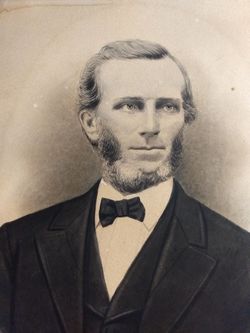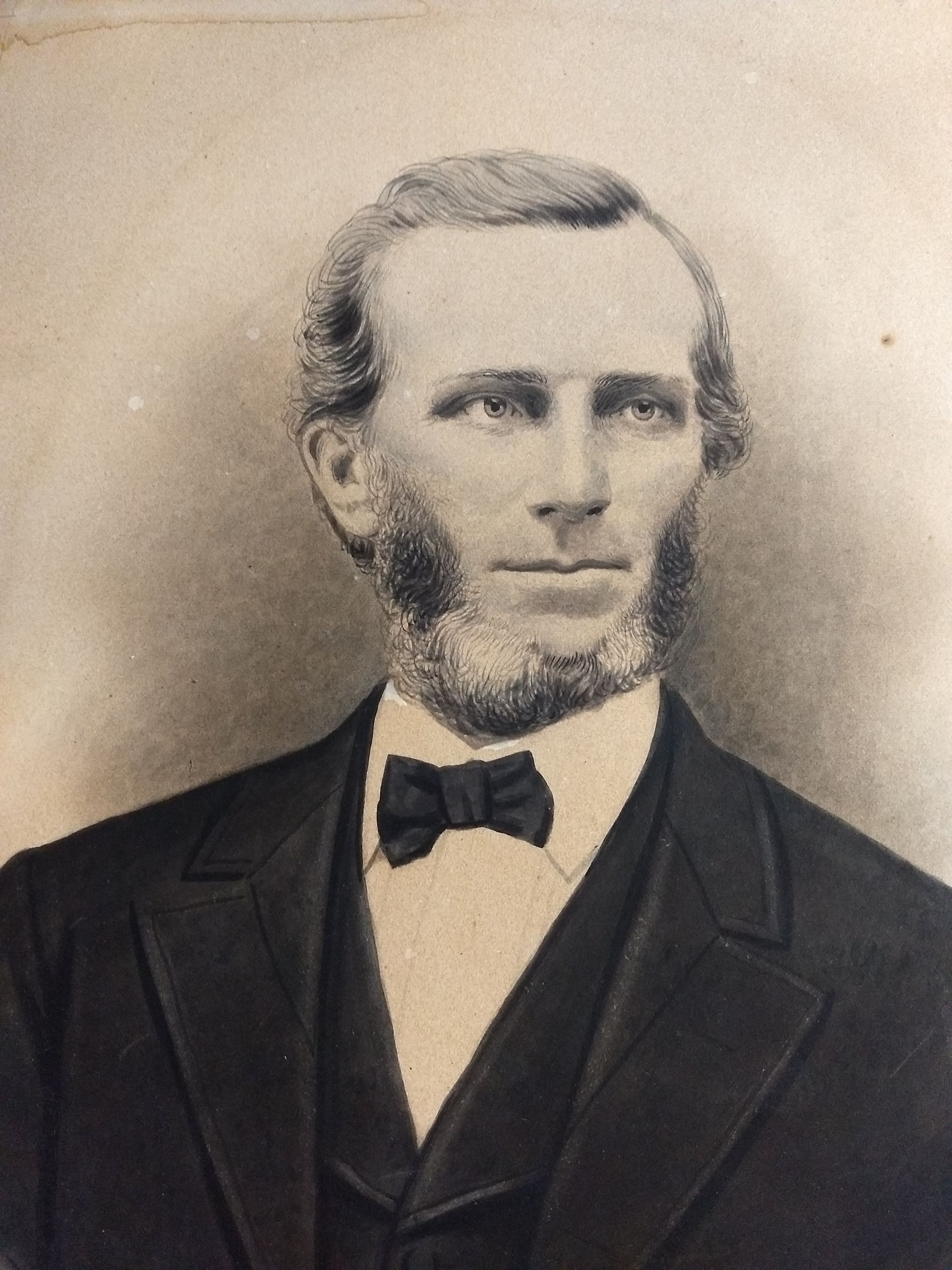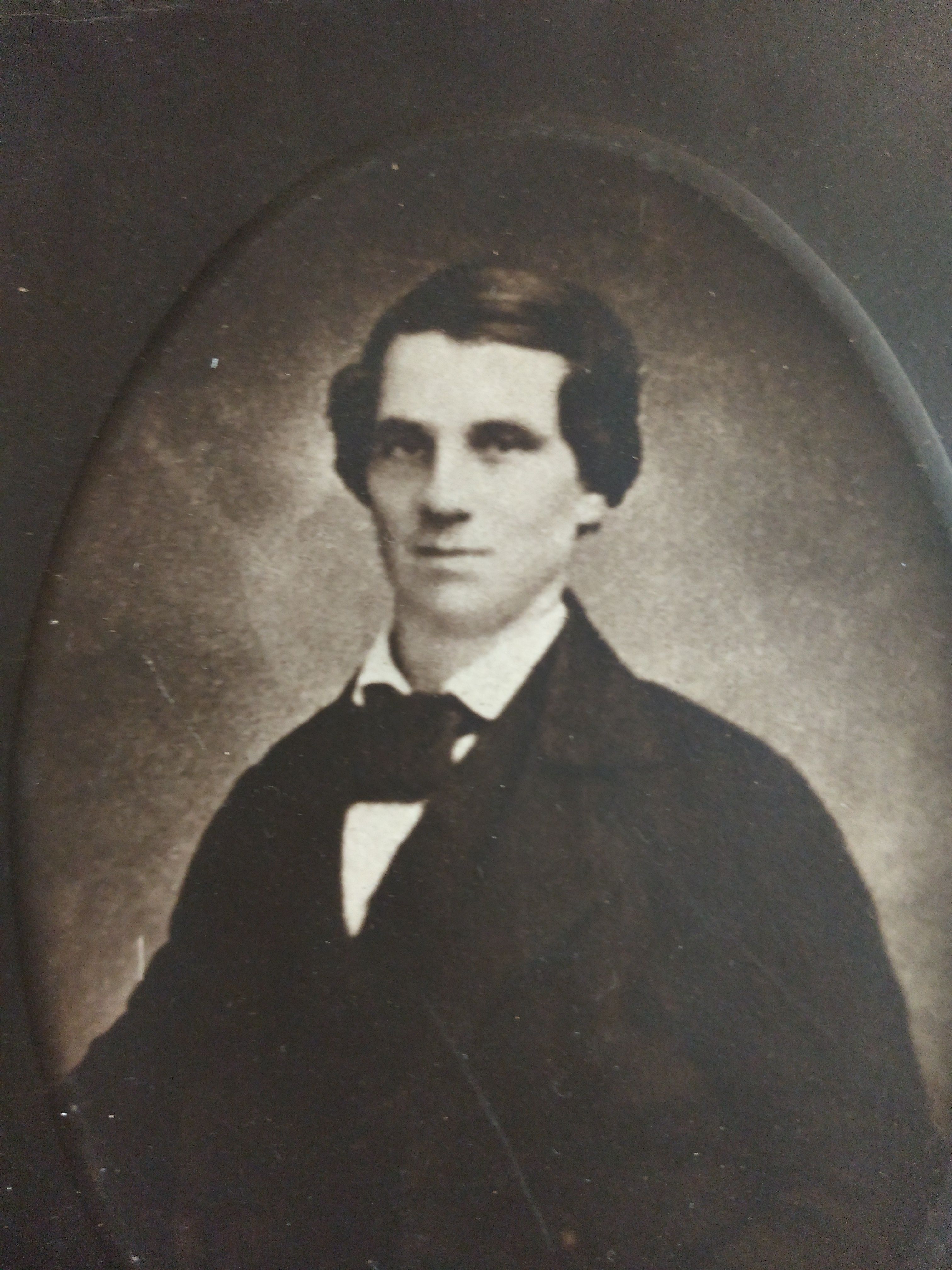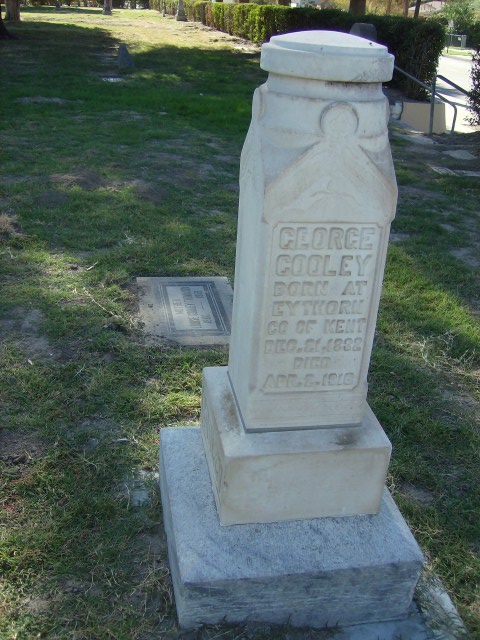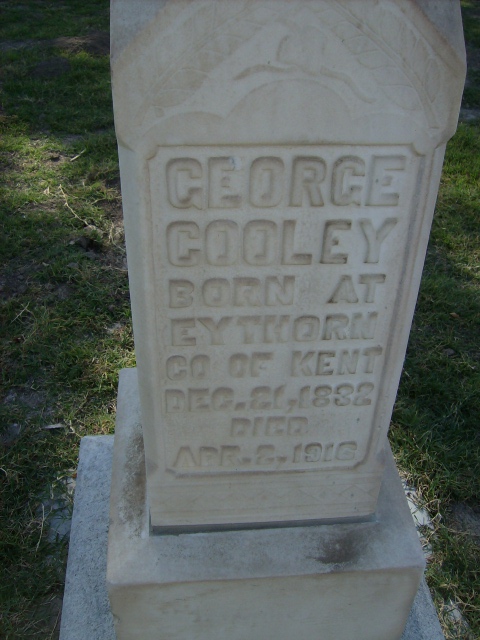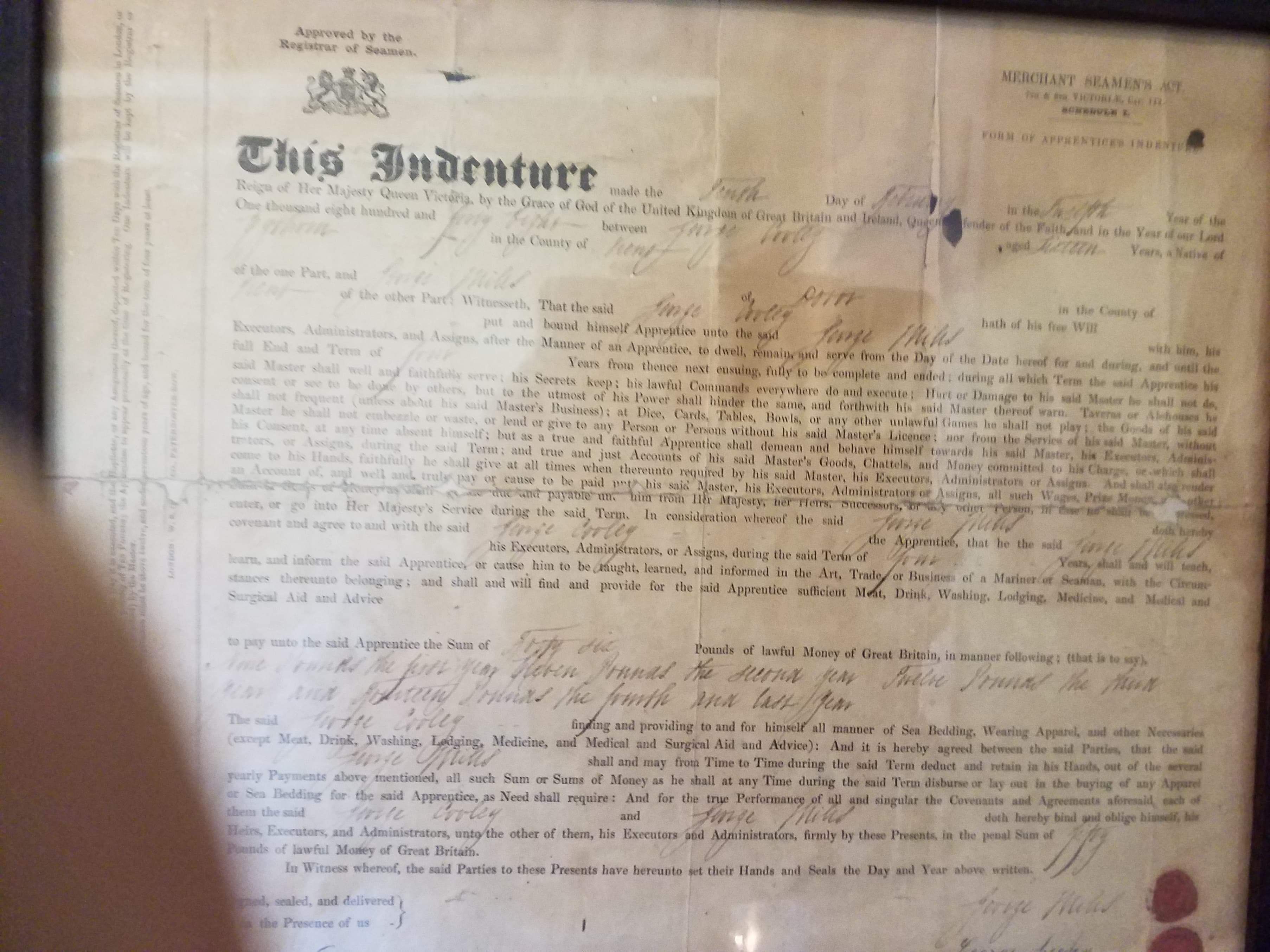George Cooley's Dissent Brings Utah Family Out
Scattered throughout California are considerably more than 100 descendants of George and
Ellen Toputt Cooley who arrived in the San Bernardino Valley May 11, 1857 and camped on the banks of the Santa Ana River four miles south of the little pioneer City of San Bernardino.
Today 100 years later, the old Cooley home, started in 1862 after the flood of that year wiped out
the original home still stands. A week ago scores of George and Ellen Cooley's grandchildren gathered at the old farm to observe the centennial of the historic event.
Wagon Caravan
The Cooley's arrived in a caravan of 11 wagons 10 of which had started from Nephi, Utah on
March of that year after becoming dissatisfied with conditions in the Mormon territory particularly the mounting tension between the Brigham Young Leadership in Utah and the federal administration of President James Buchanan. In his later years Cooley related how he had dared to speak up in a public meeting at Salt Lake and denounce plural marriage. The next day fearing it would be uncomfortable to stay in Salt Lake he moved south of Nephi.
At Nephi the Canavan of 10 English families was formed a passport obtained from a church bishop there
and the group started for California. In the company were several families that were to become leaders in pioneer Sand Bernardino. They included those of James Singeton, Sidney Mee, Henry Goddcell,
Isaac Bessant, W. Watts, W Witby, J Rebbeck, A. Hunt and J. Witworth. Cooley had been instigator of the emigration but it was Singleton and Bessant who commanded the caravan.
Born In England
Cooley had been born in Eythorn, Kent, England, on December 21, 1831. As a young man he was made
a foster son of a large landowner by name of Mills but upon the latter's death started out to see the world as a sailor. In four years on the seas he stopped in various ports on the continent of Europe and visited America.
It was on the United States ship Cumilius that on May 11, 1853 George Cooley married Miss Ellen Tolputt, an English girl whose family was headed for the United States. The marriage was performed
off the island of Monte Cristo in the West Indies by ship; Captain Charles R. Day.
The newlyweds landed in New Orleans June 5, 1853. Mrs Cooley had been born in Dover, Kent in 1834.
Her family had become coverts to the teachings of Mormon missionaries and was headed for Salt Lake.
From New Orleans the George Cooley ascended he Mississippi. a diary kept by him included the entries: "June 6 started for St Louis: arrived June 13; left for Keokuk the 14th and arrived the 15th;
left for Kanesville June 21; arrived there July 16; left for Utah July 18, arriving there October 16"
In those brief notations the young bridegroom condensed all the myriad plans necessary for overland travel by covered wagon and the ordeal of three months travel across the plains and through the Rocky Mountains. The Cooley's stopped in Salt Lake where they remained from October 1853 until March of 1857.
In his diary on leaving. Colley wrote: Lay over there (Salt Lake) three and one-half years had much trouble and annoyance from the Mormons.
Delayed at Start
It was related by Cooley that the departure of the little caravan of English families was impeded.
One hundred miles from Nephi the group was stopped, charged with traveling under false passport and Cooley returned to Nephi where the bishop verified the passport. The "passport" rule must have been an unofficial one enforced by Utah for the travel was all within the United States. The year of 1857 was one of severe tension, the one in which the faithful Mormons were recalled from San Bernardino to Salt Lake the one of the Mountain Meadows massacre and that of the Mormon War in which the U. S. Army
was sent against Salt Lake.
Indians were in something of an ugly mood in 1857 too but none bothered the Cooley caravan. En route,
at about the present Utah Nevada line, a settler decided to join them. This man Williams had lived on the Virgin River for four years and was both known and trusted by the natives. Indians came into camp several nights and on one occasion the visiting Indain chief became curious over a white papoose, Cooley's infant son, John who had been born en route. The Cooley baby was passed around, returned and the Indians left. The next caravan following that 10 English families was the on wiped out at Mountains Meadows. On arriving in San Bernardino Valley the travelers camped temporarily. Cooley
bought 200 acre of land extending north from the Santa Ana River, paying $3.50 an acre for the farm.
This farm was inundated in the big flood of 1862 which damaged all buildings beyond repair. When the flood waters subsided Cooley bought 70 more acres north of and adjoining his original farm. On the new acreage he built his new home a one story adobe. Frame additions and a second store were added from time to time. Other acreage was added until in 1890, Cooley had a farm of 400 acres through part of the south end along the river, was never cultivated after the flood.
Headed Supervisors
In addition to his farming Cooley took considerable interest in public affairs. For 12 years, he served as
road supervisor of district. Next he ran for supervisor and was reelected, running ahead of his ticket.
In 1887 Cooley was named Hariman of board of Supervisors, His service in county office came at the
time of the growing tension between San Bernardino and Riverside and it was in a large degree the firm
had of this chairman who guided through the direct tax program which built the Hall of Records and stone courthouse after bond issues for the purpose had been defeated.
The George Cooley's had 17 children. Two girls, Elizabeth and Victoria died in infancy and third girl Geneve, did not reach maturity. The remaining 14 became will know valley residents, many of achieving considerable prominence.
Three of George and Ellen Cooley ' children are yet living. They are Louisa Cooley Thomason who is 97 lives in San Bernardino; Rosa Cooley Chapline 83, of Escondido, and Scott Cooley 81 of San Francisco.
Norman N. Cooley for decades a prominent Colton area resident who lived on the old home place lived until 4 years ago.
For nearly 100 years, Cooley Ranch was also known as Indian Knolls. The name derived when the Indians in the San Bernardino Valley found refuge on the knolls of the property during the flood of 1862. Original owner of the property was George Cooley, born in Kent, England. He came to the area in 1853 and in 1854 purchased 200 acres at $3.50 per acre along the Santa Ana River. Mr. Cooley was Chairman of the Board of Supervisors of San Bernardino County. By 1873, the ranch was 19 years old with 400 acres, all in Colton. Because of high taxes, the ranch was sold to Villelli Enterprises of La Habra. It is now the Cooley Ranch and construction began in 1975
George Cooley's Dissent Brings Utah Family Out
Scattered throughout California are considerably more than 100 descendants of George and
Ellen Toputt Cooley who arrived in the San Bernardino Valley May 11, 1857 and camped on the banks of the Santa Ana River four miles south of the little pioneer City of San Bernardino.
Today 100 years later, the old Cooley home, started in 1862 after the flood of that year wiped out
the original home still stands. A week ago scores of George and Ellen Cooley's grandchildren gathered at the old farm to observe the centennial of the historic event.
Wagon Caravan
The Cooley's arrived in a caravan of 11 wagons 10 of which had started from Nephi, Utah on
March of that year after becoming dissatisfied with conditions in the Mormon territory particularly the mounting tension between the Brigham Young Leadership in Utah and the federal administration of President James Buchanan. In his later years Cooley related how he had dared to speak up in a public meeting at Salt Lake and denounce plural marriage. The next day fearing it would be uncomfortable to stay in Salt Lake he moved south of Nephi.
At Nephi the Canavan of 10 English families was formed a passport obtained from a church bishop there
and the group started for California. In the company were several families that were to become leaders in pioneer Sand Bernardino. They included those of James Singeton, Sidney Mee, Henry Goddcell,
Isaac Bessant, W. Watts, W Witby, J Rebbeck, A. Hunt and J. Witworth. Cooley had been instigator of the emigration but it was Singleton and Bessant who commanded the caravan.
Born In England
Cooley had been born in Eythorn, Kent, England, on December 21, 1831. As a young man he was made
a foster son of a large landowner by name of Mills but upon the latter's death started out to see the world as a sailor. In four years on the seas he stopped in various ports on the continent of Europe and visited America.
It was on the United States ship Cumilius that on May 11, 1853 George Cooley married Miss Ellen Tolputt, an English girl whose family was headed for the United States. The marriage was performed
off the island of Monte Cristo in the West Indies by ship; Captain Charles R. Day.
The newlyweds landed in New Orleans June 5, 1853. Mrs Cooley had been born in Dover, Kent in 1834.
Her family had become coverts to the teachings of Mormon missionaries and was headed for Salt Lake.
From New Orleans the George Cooley ascended he Mississippi. a diary kept by him included the entries: "June 6 started for St Louis: arrived June 13; left for Keokuk the 14th and arrived the 15th;
left for Kanesville June 21; arrived there July 16; left for Utah July 18, arriving there October 16"
In those brief notations the young bridegroom condensed all the myriad plans necessary for overland travel by covered wagon and the ordeal of three months travel across the plains and through the Rocky Mountains. The Cooley's stopped in Salt Lake where they remained from October 1853 until March of 1857.
In his diary on leaving. Colley wrote: Lay over there (Salt Lake) three and one-half years had much trouble and annoyance from the Mormons.
Delayed at Start
It was related by Cooley that the departure of the little caravan of English families was impeded.
One hundred miles from Nephi the group was stopped, charged with traveling under false passport and Cooley returned to Nephi where the bishop verified the passport. The "passport" rule must have been an unofficial one enforced by Utah for the travel was all within the United States. The year of 1857 was one of severe tension, the one in which the faithful Mormons were recalled from San Bernardino to Salt Lake the one of the Mountain Meadows massacre and that of the Mormon War in which the U. S. Army
was sent against Salt Lake.
Indians were in something of an ugly mood in 1857 too but none bothered the Cooley caravan. En route,
at about the present Utah Nevada line, a settler decided to join them. This man Williams had lived on the Virgin River for four years and was both known and trusted by the natives. Indians came into camp several nights and on one occasion the visiting Indain chief became curious over a white papoose, Cooley's infant son, John who had been born en route. The Cooley baby was passed around, returned and the Indians left. The next caravan following that 10 English families was the on wiped out at Mountains Meadows. On arriving in San Bernardino Valley the travelers camped temporarily. Cooley
bought 200 acre of land extending north from the Santa Ana River, paying $3.50 an acre for the farm.
This farm was inundated in the big flood of 1862 which damaged all buildings beyond repair. When the flood waters subsided Cooley bought 70 more acres north of and adjoining his original farm. On the new acreage he built his new home a one story adobe. Frame additions and a second store were added from time to time. Other acreage was added until in 1890, Cooley had a farm of 400 acres through part of the south end along the river, was never cultivated after the flood.
Headed Supervisors
In addition to his farming Cooley took considerable interest in public affairs. For 12 years, he served as
road supervisor of district. Next he ran for supervisor and was reelected, running ahead of his ticket.
In 1887 Cooley was named Hariman of board of Supervisors, His service in county office came at the
time of the growing tension between San Bernardino and Riverside and it was in a large degree the firm
had of this chairman who guided through the direct tax program which built the Hall of Records and stone courthouse after bond issues for the purpose had been defeated.
The George Cooley's had 17 children. Two girls, Elizabeth and Victoria died in infancy and third girl Geneve, did not reach maturity. The remaining 14 became will know valley residents, many of achieving considerable prominence.
Three of George and Ellen Cooley ' children are yet living. They are Louisa Cooley Thomason who is 97 lives in San Bernardino; Rosa Cooley Chapline 83, of Escondido, and Scott Cooley 81 of San Francisco.
Norman N. Cooley for decades a prominent Colton area resident who lived on the old home place lived until 4 years ago.
For nearly 100 years, Cooley Ranch was also known as Indian Knolls. The name derived when the Indians in the San Bernardino Valley found refuge on the knolls of the property during the flood of 1862. Original owner of the property was George Cooley, born in Kent, England. He came to the area in 1853 and in 1854 purchased 200 acres at $3.50 per acre along the Santa Ana River. Mr. Cooley was Chairman of the Board of Supervisors of San Bernardino County. By 1873, the ranch was 19 years old with 400 acres, all in Colton. Because of high taxes, the ranch was sold to Villelli Enterprises of La Habra. It is now the Cooley Ranch and construction began in 1975
Inscription
San Bernardino Pioneer plaque
Family Members
-
![]()
Anna M Cooley Miller
1854–1877
-
![]()
George Mills Cooley
1855–1923
-
![]()
John Cooley
1857–1892
-
![]()
Edward M "Ted" Cooley
1859–1936
-
![]()
Louise Cooley Thomason
1860–1959
-
![]()
Charles Camillus Cooley
1861–1928
-
![]()
Frederick Francis Cooley
1864–1908
-
![]()
Ellen "Ella" Cooley Clyde
1865–1951
-
Fannie Cooley Archibald
1866–1904
-
![]()
Frank Lester Cooley
1867–1940
-
![]()
William A Cooley
1869–1909
-
Victoria Cooley
1872–1872
-
Geneva E. Cooley
1873–1875
-
Rose Cooley Chapline/ Purdy
1876–1959
-
![]()
Winfield Scott Cooley
1876–1962
-
![]()
Norman Henry Cooley
1879–1952
Sponsored by Ancestry
Advertisement
Records on Ancestry
Advertisement
